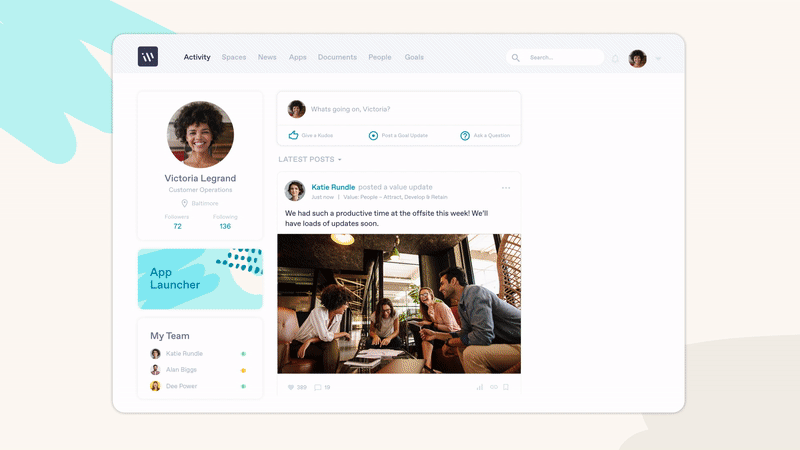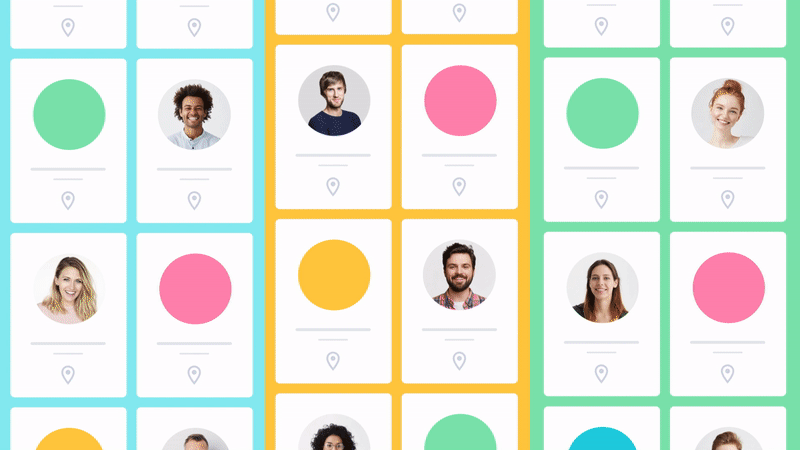7 Ways Employee Apps Can Improve Employee Experience

Richard Barrett
Director of Marketing
3 Feb 2023

Employee experience is more than just a buzzword – it could be the most important factor in your company’s success.
The way your employees feel about your brand, company mission, purpose, and culture has a direct effect on employee engagement, retention, and performance . The trouble is, it’s a tricky concept to pin down.
Employee experience covers everything from the moment your employees walk into the building in the morning (or turn their laptop on from home), to the moment they shut up shop at night. It runs throughout the entire employee lifecycle from recruitment to exit.
If you don’t have an active strategy for managing employee experience in your workplace, you could be missing out on some big benefits. Organizations that score in the top 25% for employee experience report nearly three times the return on assets as those in the bottom 25% .
And the effects don’t stop there. The Work Institute’s 2020 Retention Report found that the top three reasons employees cited for leaving their jobs were a lack of career development opportunities, poor work-life balance, and manager behavior – all key factors in the employee experience.
Given that US companies are collectively spending $1 trillion on voluntary turnover each year, and against the background of the ongoing ‘war for talent’, the stakes have never been higher. In this piece, we’ve got 7 ways employee apps can improve employee experience.

Using an employee app to improve employee experience
Building a positive culture and employee experience takes time and active, concerted effort. But there is one thing you can do to begin improving your employees’ experience of the workplace straight away: use an employee app.
An employee app is any app that makes work easier for your employees. Given the massive increase in remote and hybrid working brought on by the events of the past two years, there has been a huge influx in tools that help people to collaborate, communicate and do their job at a distance. Employee productivity is so important — we all want to help a disengaged employee become and engaged one.
An employee app can also help your team to receive praise and recognition for their work, build meaningful relationships with colleagues, and access all the information they need to do their job in one central location.
Here are seven ways employee apps can improve employee experience for your workforce.

1. Promote employee feedback and let your people feel heard
One of the best ways to understand employee experience at work is simply to ask them about it. Human resources seeking out employee feedback and insights can help you to show them their opinions matter, and to spot any potential problems before they lead to disengagement and decreased productivity.
Employee experience apps can help you to streamline this process, by setting up regular pulse surveys and collecting employee feedback (for example, on new policies or procedures) via polls.
From the employee side, responding to these is a quick and simple digital experience process that allows them to share their views without the hassle of replying to an email or filling out an unwieldy PDF form. It is a positive employee experience for all employees, and not just human resources.
And for the company, the benefits of employees feeling heard at work are clear: highly engaged employees are three times more likely to report feeling heard at work than others , and 74% feel that they are more effective at their job when they feel heard.
2. Accurately gauge employee engagement using analytics
Can you identify a disengaged employee from an engaged employee? Do you know how many of your employees are reading your internal communications, particularly with the advent of remote work? Even if you do, it’s hard to know what content really resonates with them using traditional tools like email.
When it’s done well, internal communications can be a positive employee experience and provide inspiration for employees to continue working together toward a shared goal. Employees value a steady flow of information telling them how the company is progressing towards its goals, and, by extension, how they fit into the narrative.
But, no matter how well-crafted the message is, there’s little point if you can’t see who’s reading it. Employee experience apps like Workvivo can give you detailed content analytics including impressions and interaction tracking on posts, articles, and events, so you can find out what works (and what doesn’t).

3. Foster a culture of healthy competition
According to a study by software company Prodoscore, 67% of survey respondents said that competition with peers motivated them to do better work. While leaders should be wary of the potential negative effects of an over-competitive work environment (especially with remote work), when it’s done right a degree of healthy competition can help you achieve great results – like increased productivity and motivated, happy teams.
The key is to ensure that competition remains purposeful and exists within a wider culture of support and helping others to succeed.
There are several ways that employee apps can help with this. For example, sharing big achievements with the whole company through an internal blog post or newsletter can be a great way to motivate others to succeed. Encouraging debate and constructive conflict through Q&A and discussion features can also be useful in a digital experience.
When employee apps include a social media-style news feed (like Workvivo’s), managers can also encourage employees to take part in challenges (which could be either related to their work or not). This can be effective when working with a disengaged employee.

4. Enhance processes for smoother onboarding
Employee experience starts the moment a new hire is brought on board and, even in a remote work world, their first impressions of working for a company can be crucial – a strong onboarding process can increase retention by 82% .
Despite this, Gallup data suggests that only 12% of companies offer a great onboarding process – a problem that has only worsened with the increase in remote hires and the need to effectively onboard new hires from a distance.
Employee apps like Workvivo can immediately provide new hires with a full and easy-to-navigate directory of everyone who works at the company, so they can understand how everyone fits together. From day one, they can access all of the documents and information they need in one central and convenient hub.
Apps can also help new employees to start building workplace relationships and getting involved with the company culture right from the start, by participating in a poll or employee survey, sharing and reacting to posts, and communicating with their new colleagues. This has been shown to improve employee satisfaction.

5. Reward and recognize great work
Another great use of employee experience apps is to provide rewards and recognition for your remote employees when they do great work. For example, using Workvivo, you can create and release awards and badges that allow employees to nominate their colleagues when they go above and beyond.
You can also share successes digitally in blog posts, articles and newsletters – and make sure everyone sees them.
Celebrating wins big and small doesn’t just make engaged employees feel good – it can have big effects for business too. In fact, 21% of employees that don’t feel they’re recognized when they do great work have interviewed for another job in the last three months , compared to just 12.4% of those that do feel recognized.
Seeing their peers’ achievements recognized can also motivate other engaged employees to do their best work, which can extend to an improved customer experience and higher employee satisfaction.

6. Provide the tools your team need for effective collaboration
Collaboration in the workplace can lead to better productivity, engagement, and quality of work. Internal communication has never been as important. A Stanford University study found that teams persisted up to 64% longer when working on a task together than when working individually.
Companies need tools that allow employees to effectively collaborate with colleagues – which is where employee apps come in. There are many different tools for collaboration available, from video-conferencing software like Zoom or Skype to chat tools like Slack or MS Teams, which allow teams to communicate virtually.
There are also many tools designed for collaborative project management, like Trello or Notion.
Whichever tool you use, it’s never been more important to make sure your employees have everything they need for fruitful and effective collaboration, and for customer experience and employee satisfaction. It could even be one of the biggest drivers of positive employee experience: research by Queens University of Charlotte found that 75% of employees rated teamwork and collaboration as “very important” in the workplace.
software like Zoom or Skype to chat tools like Slack or MS Teams, which allow teams to communicate virtually.
There are also many tools designed for collaborative project management, like Trello or Notion.
Whichever tool you use, it’s never been more important to make sure your employees have everything they need for fruitful and effective collaboration. It could even be one of the biggest drivers of positive employee experience: research by Queens University of Charlotte found that 75% of employees rated teamwork and collaboration as “very important” in the workplace.

7. Create an open and transparent culture
According to Forbes, 50% of employees believe that a lack of transparency is holding their company back. Seventy percent of respondents to a Harvard Business Review survey said that management communicating openly and continually about strategy was the most important driver of employee engagement in the workplace. The figures are clear: today’s workforce values transparency.
While true transparency within a company involves encouraging everyone to share ideas openly, it’s important to set the right example by starting from the top down – which employee apps can help with. They can help you to share your purpose, strategy, values, and even failures with your remote employees – all in an easy interface they can access wherever they are.

Workvivo – the employee experience app that brings your entire company together
Using an employee app can help your employees feel more connected to each other, collaborate more effectively, and better understand your company’s mission and values. All of this results in remote employees and in-office employees who are more engaged, motivated to succeed, and likely to stay at your company for longer. It can also help to improve customer experience.
At Workvivo, we’ve built an employee app suitable for the future of work, designed to be your internal communications tool, company intranet, and social network all in one, with an amazing digital experience.
Book a demo today to find out how we could help you to transform your employee experience.

